Soviet war cemeteries in Germany
As a Soviet war graves in Germany cemeteries are called on German soil that only the graves of victims of war and tyranny under German graves Act from the former Soviet Union host. They are usually kept in a uniform, culture-typical style and equipped with a memorial. They form separate facilities or separate sections of a communal civil cemetery that are clearly delimited by spatial and design features. They are to be distinguished from individual war graves of Soviet citizens in communal civil cemeteries. Both war cemeteries and individual war graves are to be permanently preserved by the German state in accordance with the Graves Act and the 1992 agreement on the preservation and maintenance of war cemeteries between the Commonwealth of Independent States (CIS) and the Federal Republic of Germany.
A distinction must also be made between Soviet and Russian war graves. The Soviet Union was founded in 1922. War graves from the First World War (1914–1918) are therefore not counted among the Soviet, but among the Russian war graves. The Soviet war dead, on the other hand, are by no means composed solely of citizens of Russian nationality, but rather show the same ethnic dispersion due to the multi-ethnic character of the Soviet Union.
Soviet war graves in Germany
According to the Office for War Graves Care and Memorial Work of the Russian Embassy in Berlin, the graves of around 640,000 citizens of the former Soviet Union are known in Germany to this day . Most of the dead are victims of the Second World War or the Great Patriotic War between 1941 and 1945, for example soldiers , officers and civil servants of the Red Army who perished in combat operations or in captivity , but also civilians living on German soil had been used as slave labor . They rest in individual or collective graves in community cemeteries and in large war cemeteries with tens of thousands of dead.
The graves of around 17,000 members of the western group of the Soviet armed forces and their families, who found their final resting place in the German Democratic Republic (GDR) between 1952 and 1990, represent a specialty . Until the end of the 1960s, members of the military who died during military service were buried in the large Soviet site cemeteries and thus directly next to the war dead on the war cemeteries. Afterwards the burial took place almost exclusively in the homeland. Only children and civilians were still occasionally buried in the garrison cemeteries until the 1980s. Therefore, the Soviet graves in Germany do not allow any reliable statement to be made about the number of members of the Soviet Army who died on German soil in the post-war period .
After the Second World War, the Allies laid war cemeteries in many places in Germany . In the Soviet occupation zone, the Soviet Military Administration in Germany (SMAD) regulated the establishment of the site cemeteries from 1946 onwards. This is where mainly military personnel who died at the end of the war and after the war were buried. But partly also buried on the battlefields of Red Army and perished forced laborers were subsequently to these systems reburied . In many cases, the reburial took place anonymously, and documents about it often do not exist, which often makes it difficult for relatives to find the final burial site.
In this way, 18 large Soviet site cemeteries, which are also war cemeteries, as well as a large number of small honorary cemeteries were created in East Germany, in the area of the later GDR. In addition to their actual purpose of commemorating the victims of the war, these cemeteries were also used politically during the period of real socialism in the GDR. They formed the backdrop for political holidays, such as the annual Liberation Day on May 8th or the day of the Great October Socialist Revolution on November 6th. To this day , wreaths are laid at such places , especially on May 8th or on the day of national mourning in November.
Care of the cemeteries
In a bilateral agreement with the Russian Federation (Agreement of December 16, 1992 between the Government of the Federal Republic of Germany and the Government of the Russian Federation on War Grave Care ) , the Federal Republic made clear commitments in 1992 to preserve and maintain these grave sites:
- (1) The Government of the Federal Republic of Germany and the Government of the Russian Federation guarantee the protection of the war graves and the permanent right of rest for the war dead of the other side in their territory and endeavor to keep the vicinity of the war cemeteries free of all facilities that are associated with dignity these sites are not compatible.
- . ..
- (3) The Government of the Federal Republic of Germany guarantees, at its own expense, the maintenance and care of Russian war graves in the territory of the Federal Republic of Germany.
An identical agreement has also existed with Ukraine since 1997 . Conversely, the contracting states also undertook to preserve German war graves on their own territory, but this is usually guaranteed in cooperation and on the initiative of the German War Graves Commission .
The post-war graves of around 17,000 Soviet military personnel and civilians who were buried between April 1, 1952 and 1994 were not taken into account in the legal regulations of 1992. They also do not fall under the Graves Act and are therefore neglected in many places. The municipalities often use the cost argument and refer to the non-existent legal obligation to preserve these graves.
Locations
The responsible embassy secretariat of the Russian Federation has identified almost 3,400 locations throughout Germany where Soviet war dead from the Second World War were buried. These include both the large war cemeteries and communal cemeteries with individual war graves. Of these, around 825 are in the east of Germany and 2615 in the west. Almost half of the dead are shared between both parts of the country. More than 300,000 war victims (soldiers and forced laborers) are in the east. In western Germany, where the Red Army was never involved in combat, the 340,000 dead buried here are exclusively prisoners of war and forced laborers. In total, the around 640,000 people mentioned at the beginning are buried at all of these locations. The identity of very few (only about a quarter) is known.
In the case of Soviet victims of the Second World War, a high number of unreported deaths can also be assumed. Many were hastily buried on the edge of the battlefield during the last days of the war in April and May 1945. In and around Berlin in particular, accidental finds are still being made today. Numerous Red Army soldiers are still missing. Others were buried on the territory of Soviet army garrisons after the end of the war and were never reburied.
List of Soviet war graves and burial grounds for war victims in Germany
In alphabetical order by state and town:
Baden-Württemberg
| designation | place | description | Victim | image |
|---|---|---|---|---|
| memorial | Friedrichshafen | 450 forced laborers in the armaments industry | 450 |
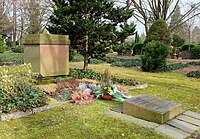
|
Berlin
| designation | place | description | Victim | image |
|---|---|---|---|---|
| Soviet Memorial (Treptower Park) | Berlin-Alt-Treptow | with about 7,000 fallen soldiers, the central memorial | 7,000 |
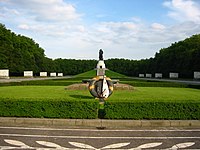
|
| Old Hohenschönhausen | Cemetery for 1647 Soviet nationals and other victims from all over Europe as well as German soldiers and civilian victims of the Second World War found their final resting place in the Catholic cemeteries of St. Hedwig and St.-Pius in Konrad-Wolf-Straße . |
1647 | ||
| Ehrenfriedhof at the Parkfriedhof Marzahn | Berlin-Marzahn | with about 150 Soviet military personnel | 150 |

|
| Soviet Memorial (Schönholzer Heide) | Berlin-Niederschönhausen , Schönholzer Heide | with about 13,000 fallen soldiers | 13,000 |

|
| Soviet Memorial (Tiergarten) | Berlin Tiergarten | with about 2,500 fallen soldiers | 2,500 |

|
Brandenburg
| designation | place | description | Victim | image |
|---|---|---|---|---|
| Soviet Cemetery of Honor (Baruth / Mark) | Baruth / Mark | |||
| Soviet memorial | Brandenburg on the Havel | 255 Soviet soldiers who fell during the fighting were buried in individual and collective graves at the Soviet memorial until October 1945. At least 681 Soviet military personnel found their final resting place throughout the city. | 255 | |
| Soviet cemetery of honor at Dammtor or Dammfriedhof | Jueterbog | A total of around 110 Soviet war dead. | 110 |

|
| Soviet memorial (Kleinmachnow) | Kleinmachnow | A total of 104 soldiers are buried on the site. | 104 |

|
| War cemetery and garrison cemetery on Michendorfer Chaussee | Potsdam | 5000 to 6000 war deaths and post-war deaths. The largest Soviet site cemetery on East German soil. | ||
| Ehrenfriedhof am Bassinplatz | Potsdam | 383 Soviet war victims. | 383 | |
| Soviet war cemetery Reitwein | Riding wine | approx. 3,000 | ||
| Schöneiche near Berlin | Cenotaph, burial place for 239 soldiers and officers of the Red Army who died in combat | 239 | ||
| Zeuthen , district of Miersdorf | Cemetery of honor for 550 Soviet dead | 550 |
Hamburg
| designation | place | description | Victim | image |
|---|---|---|---|---|
| Soviet war cemetery in Hamburg-Ohlsdorf | Hamburg-Ohlsdorf | |||
| Soviet war cemetery Hamburg-Bergedorf | Hamburg-Bergedorf | 651 Soviet prisoners of war from 1941/1942 from Neuengamme concentration camp rest here . A memorial by the St. Petersburg sculptor Grigory Yastrebenetsky shows a prisoner of war with his hands tied in front of a barbed wire barn. | 651 |

|
Hesse
| designation | place | description | Victim | image |
|---|---|---|---|---|
| POW camp and war cemetery | Dietkirchen (Limburg an der Lahn) | War cemetery of the First World War, used in the Second World War as the cemetery of the "Stammlager XII" near Diez; In addition to Russian and Soviet dead, at least victims from eight other countries. | circa 945 |

|
| Soviet war cemetery in Herleshausen | Herleshausen | 1,593 mostly Soviet prisoners of war, 24 mostly Soviet prisoners of war in the former hospital. | 1593 |
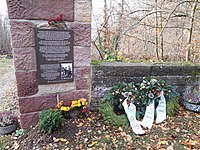
|
| Russian military cemetery Klein-Zimmer | Small rooms | 435 Soviet prisoners of war, memorial stone. | 435 | |
| Wegscheide forest cemetery | Bad Orb | About a kilometer south of the Children's Village crossroads is a forest cemetery with 1,430 dead Soviet prisoners of war prisoners main camp (STALAG) IX B . | 1,430 |
Mecklenburg-Western Pomerania
| designation | place | description | Victim | image |
|---|---|---|---|---|
| Soviet military cemetery in Ahlbeck | Ahlbeck , Usedom | Soviet cemetery of honor with a memorial for 85 soldiers and officers of the Red Army who fell on Usedom | 85 |

|
| Guestrow | Grave site for 617 Soviet prisoners of war and slave labor | 617 | ||
| Hagenow |
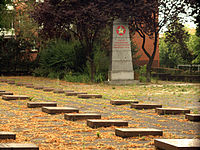
|
|||
| Soviet cemetery of honor on Grabower Allee | Ludwigslust | Soviet cemetery of honor on Grabower Allee for a total of 220 Soviet victims of World War II, including fallen Red Army soldiers as well as prisoners of war and forced laborers | 220 | |
| "Leninhain" memorial between Fischerstrasse and Haußmannstrasse as well as Mühlenstrasse and Bahnhofstrasse | Pasewalk | The grove of honor, the cornerstone of which was laid on Lenin's 100th birthday in April 1970, includes a grave complex for 21 Soviet soldiers, who were buried in 13 graves, as well as a peace column, connected to a red memorial wall with a prisoner angle for the victims of fascism and a Soviet star. A pyramid with a Soviet star on the top, which originally stood in the center of the facility inaugurated in October 1971, was removed after 1990. The small obelisks with Soviet stars originally standing in front of the graves of the Soviet soldiers were damaged in 1999 and were then also removed. | 21st |

|
Lower Saxony
| designation | place | description | Victim | image |
|---|---|---|---|---|
| Soviet war cemetery Bergen-Lohheide (Hörsten) | Bergen-Belsen | 14 mass graves with an estimated 50,000 dead (officially recorded: 23,215 dead) | 50,000 |

|
| "Russian Cemetery" | Clausthal-Zellerfeld | A memorial with a grave field at the Mittlerer Pfauenteich commemorates the more than 100 victims of the Soviet forced laborers in the bombing of the Tanne plant . |

|
|
| Hahnöfersand | Jork | 77 Russian war graves from the First World War on the Elbe island. In the prison area, not accessible. | 77 |
North Rhine-Westphalia
| designation | place | description | Victim | image |
|---|---|---|---|---|
| War cemetery on Gallberg | Dusseldorf | Russian cemetery of honor on Gallberg for around 1500 Soviet prisoners of war | 1500 | |
| Gravesite for Soviet prisoners of war and slave labor | Gelsenkirchen-Horst | 884 |

|
|
| Russian cemetery of honor Zur Maasbeck | Hattingen | |||
| Russian cemetery of honor in Vosshagen | Hückeswagen | |||
| Soviet cemetery of honor | Lennestadt |

|
||
| Soviet war cemetery Simmerath-Rurberg | Simmerath - Rurberg | 2,322 Soviet citizens, forced laborers and prisoners of war | 2,322 |

|
| Soviet Stukenbrock Cemetery of Honor | Holte-Stukenbrock Castle | about 65,000 prisoners of war and forced laborers of the main camp VI K (326) . | about 65,000 |
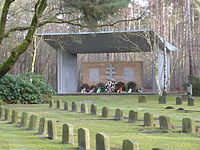
|
Saarland
| designation | place | description | Victim | image |
|---|---|---|---|---|
| Heusweiler community cemetery | Heusweiler | Grave site of 100 to 150 Soviet foreign workers in the Heusweiler municipal cemetery. The workers were mainly employed in the mining and track construction of the Reichsbahn. About the details of her death z. Little known at the moment. After 1990, the community of Heusweiler provided the graves with bronze plaques on which all known dead are listed. | 100 to 150 |
Saxony
There are 910 war cemeteries on the territory of the Free State of Saxony. These are subdivided into 26,000 individual graves and collective graves with a total area of approx. 93,000 m². A total of 147,000 war victims were buried in these graves. More than 25,000 of them [Soviet citizens, forced laborers] are buried in the Ehrenhain in Zeithain alone .
| designation | place | description | Victim | image |
|---|---|---|---|---|
| Soviet cemetery | Chemnitz-Reichenhain | Soviet cemetery for 1,130 dead prisoners of war and slave labor. | 1130 |
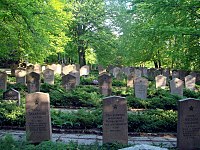
|
| Soviet garrison cemetery in Dresden | Dresden | With around 1200 graves of around 2300 dead. War deaths and post-war deaths. | 2300 | |
| Soviet war graves in the Protestant cemetery | Löbau | |||
| Stalag IV H | Zeithain near Riesa | about 70,000 dead prisoners of war | 70,000 | |
| Soviet honor grove | Leipzig | A demarcated complex within the city's east cemetery to commemorate the fallen Soviet soldiers with around 260 individual graves | 1,758 |

|
Saxony-Anhalt
| designation | place | description | Victim | image |
|---|---|---|---|---|
| Soviet cemetery of honor | Groeningen | Soviet cemetery of honor, where 80 prisoners of war as well as women, men and children are buried who were deported to Germany during the Second World War and were victims of forced labor. | 80 | |
| Lutherstadt Wittenberg | Individual and collective graves for 933 fallen Red Army soldiers, prisoners of war and deported civilian workers | |||
| Soviet memorial cemetery in Stendal | Stendal |

|
Schleswig-Holstein
| designation | place | description | Victim | image |
|---|---|---|---|---|
| Facility for the Soviet war victims in Lübeck during World War II | Lübeck | War cemetery with Soviet war victims during the Second World War in Lübeck. |

|
Thuringia
| designation | place | description | Victim | image |
|---|---|---|---|---|
| Bad Liebenstein | Soviet memorial commemorates 23 victims | |||
| Gotha main cemetery | Gotha | 77 Soviet dead from the Second World War lie in the main cemetery. 51 of these are known by name. The graves are maintained annually by Russian and German young people as part of a work camp run by the Volksbund Deutscher Kriegsgräber. | 77 | |
| Heilbad Heiligenstadt | (Location) | 70 | ||
| Soviet cemetery in the Belvedere palace gardens | Weimar |

|
||
| Soviet cemetery of honor in Ilmpark | Weimar | 649 Soviet war dead | 649 |

|
See also
literature
- Frank Schumann : Monuments of Liberation: Traces of the Red Army in Germany. New Life, 2020, ISBN 978-3-355-01890-6 .
Web links
- Working Group on Soviet Graves and Memorials in Germany ( Memento from August 31, 2012 in the Internet Archive )
- Soviet war cemeteries in Germany
- Soviet memorials in Berlin
- Gravesites of Soviet citizens in the area of the Free State of Saxony / Documentation Center Dresden
- Soviet prisoners of war / Association for contacts with countries of the former Soviet Union
Individual documents and footnotes
- ^ Office for War Graves Care and Memorial Work. In: Embassy of the Russian Federation. August 15, 2014, accessed on March 14, 2020 (German).
- ↑ Wolfgang Ditting : Soviet graves and memorials in East Germany. ; Verlag Wostok, Berlin 2005, ISBN 978-3-932916-31-1 .
- ↑ The agreement between Germany and Ukraine on the preservation and care of war graves was published in BGBl 1997.
- ↑ Archived copy ( memento of the original dated November 22, 2015 in the Internet Archive ) Info: The archive link was inserted automatically and has not yet been checked. Please check the original and archive link according to the instructions and then remove this notice.
- ↑ Soviet war cemeteries in Germany. Office for war cemeteries and memorial work
- ↑ Information on the online project Memorials to Fallen ; Retrieved April 9, 2015.
- ↑ Michendorfer Chaussee - PotsdamWiki. Retrieved March 14, 2020 .
- ^ History of the monument
- ^ Information from the German-Russian Museum Berlin-Karlshorst and the Office for War Graves Care and Memorial Work of the Embassy of the Russian Federation.
- ↑ Soviet war graves in Hamburg-Bergedorf
- ↑ DenkFried - Monuments and Cemeteries - A page to commemorate and commemorate. Retrieved on March 14, 2020 (German).
- ↑ Printed matter 2/2880 of the Mecklenburg-Western Pomerania State Parliament, August 11, 1997, p. 137.
- ^ German-Russian Museum Berlin-Karlshorst: Soviet war cemeteries in Germany (accessed November 20, 2015)
- ↑ Wolf Karge, Hugo Rübesamen, Andreas Wagner (ed.): Inventory of political memorials of the state of Mecklenburg-Western Pomerania. Project: “Memorial work in Mecklenburg-Vorpommern” ( Politische Memoriale eV Mecklenburg-Vorpommern ), Schwerin 1998, pp. 590–593.
- ↑ Information from the Volksbund Deutsche Kriegsgräberfürsorge on the "Russenfriedhof" in Bergen / Hörsten
- ↑ Edgar Sebastian Hasse : Hamburg's prison island. In: "Hamburger Abendblatt", August 21, 2017, p. 12.
- ^ Russian cemetery of honor "Am Gallberg", Düsseldorf - photos. Retrieved March 14, 2020 .
- ↑ Searching for traces: War cemetery on Gallberg. Retrieved March 14, 2020 .
- ↑ GELSENZENTRUM - war cemeteries - victims of forced labor 1941-1945 in Gelsenkirchen. Retrieved March 14, 2020 .
- ↑ https://www.kuladig.de/Objektansicht/A-NF-20070408-0016
- ↑ Answer to a small inquiry, Landtag Saxony
- ↑ Soviet war graves in Löbau
- ^ City of Gröningen: Soviet Cemetery of Honor (accessed on November 21, 2015)
- ↑ Soviet war cemeteries in Germany at www.sowjetische-memoriale.de.
- ^ Cemetery plan of the Vorwerker cemetery
- ↑ Thuringian Association of the Persecuted of the Nazi Regime - Association of Antifascists and Study Group of German Resistance 1933-1945 (ed.): Heimatgeschichtlicher Wegweiser to places of resistance and persecution 1933–1945, series: Heimatgeschichtliche Wegweiser Volume 8 Thüringen, Erfurt 2003, p. 315 , ISBN 3-88864-343-0 .
- ↑ Soviet Cemetery of Honor

